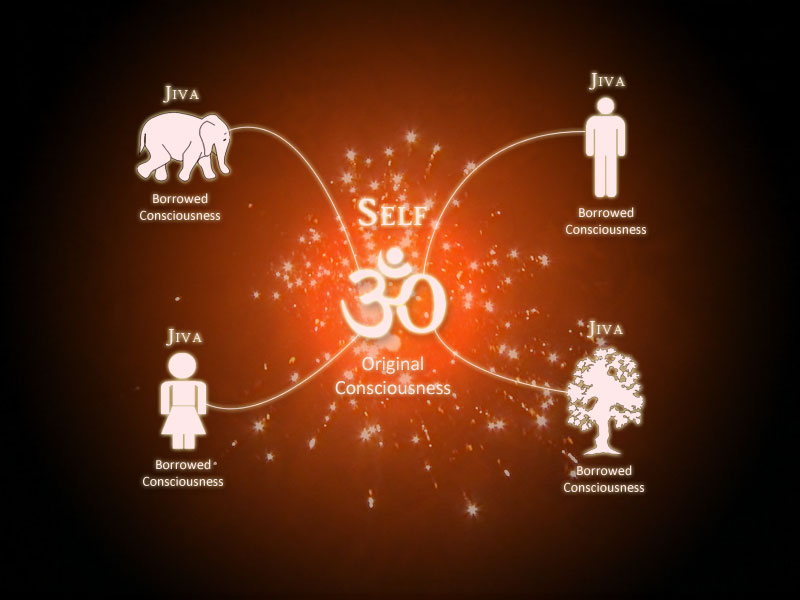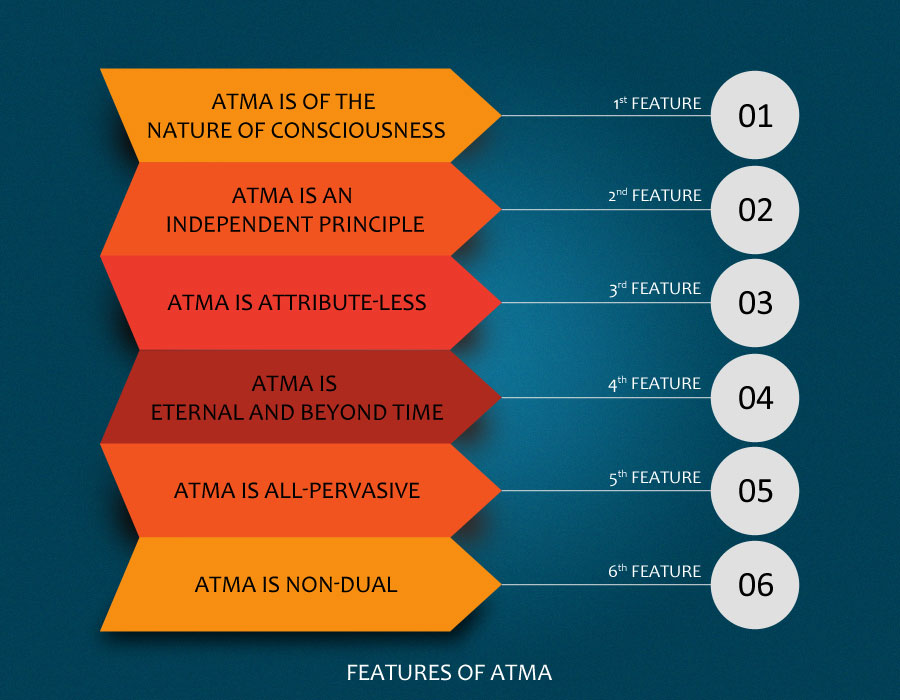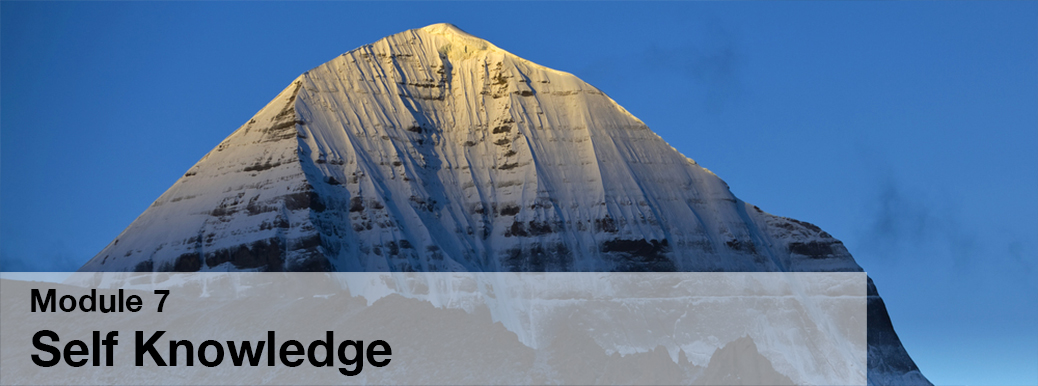Introduction
The Self in Sanskrit is called Atma or Atman. So far in the course we have used different terms to refer to the Self like Awareness, Consciousness, Substrate etc.
Even though these terms refer to the Self, there are subtle differences in meaning because these terms refer to the Self from different aspects or viewpoints.
Similarly there are different terms for Self in Vedanta like: Atma, Paramatma, Brahman, Isvara etc. which refer to the Self in its different aspects.
However unlike the English spiritual terms, the definition of terms in Sanskrit is very precise. So the subject matter of this chapter will be the Sanskrit term Atma, or as it is commonly translated in English; the Self.
Borrowed Consciousness
The 3 Bodies are Inert and Insentient
The Gross Body is made up of the 5 gross elements (space, air, fire, water and earth), the elements themselves being nothing other than matter. Since the Gross Body is made up of matter, we can say that it is material in nature. We define material as something which is a product of matter.
Similarly the Subtle Body is made up of the 5 subtle elements. Even if the elements are subtle, they are still matter. So even the Subtle Body is material in nature.
The Causal Body is also material in nature because it is nothing but Subtle and Gross bodies in seed form. It is the subtlest form of matter.
So on analysis, it is known that the 3 Bodies are material in nature. We know from science that matter is inert (Jadam). So if the 3 Bodies are inert on account of them being matter, we have to derive certain important conclusions from it.
Vedanta defines inertness as:
Since the 3 Bodies are material in nature and therefore inert, they do not have consciousness, nor can they produce consciousness. So according to scripture the 3 Bodies are inert, non-conscious and insentient in nature.
This means that not only is the physical body inert, even the mind being part of the Subtle Body is inert matter and therefore insentient. Mind lacks consciousness of its own, nor can it produce consciousness.
It’s the same with Causal Body. So the 3 Bodies lack sentiency.
What Makes the 3 Bodies Look Sentient?
I experience the 3 Bodies as sentient. I experience my body as a conscious body, conscious of its surrounding. I experience my mind as very much sentient.
So logically the 3 Bodies is known to be insentient, but experience tells us it is sentient. So how do we resolve this seeming contradiction?
Vedanta says it is possible. Suppose a poor, destitute man comes to a function wearing suit and tie; what do we infer? We infer that since he does not have any money of his own, he must have borrowed the clothes from someone else.
Similarly the scriptures say the 3 Bodies do not have natural consciousness; they have borrowed consciousness.
Without borrowed consciousness there is no difference between a statue and our physical bodies. Scriptures say the body is made up of 5 elements. From the scientific angle we say the body is composed of chemicals.
So what makes a bundle of chemicals sentient? It is borrowed consciousness.
So to enumerate our logical analysis:
If the 3 Bodies have borrowed consciousness then there has to be a lender of consciousness. We call this lender of consciousness to be the 4th factor (Turiya) of a Jiva; the first 3 factors being the Gross, Subtle and Causal Body.
The very first mantra of the famous Upanishad, Kenopanishad, starts with this same question about the lender of consciousness:
Willed by whom or prompted in whose presence does the mind land upon its objects? United with whom does the breath go in and out? Willed by whom do people speak these words? Which effulgent being unites the eyes and ears (with its functions)?
What is this 4th factor which lends consciousness; which makes the insentient body sentient? Vedanta says it is Atma, the Self.

Atma – The Lender of Consciousness
We know that a light bulb cannot shine by itself. There is another “invisible factor” called electricity which makes the bulb shine.
In the same way Atma is the “invisible factor” which makes the 3 Bodies shine with consciousness. Atma is the one that gives Jiva sentiency.
What is the Nature of Atma?
1. Atma is of the nature of Consciousness
Why do we say Atma is non-material?
Because if Atma is also another matter then it too will have to borrow consciousness from another principle. The original lender of consciousness must be a non-borrower.
Atma being the original lender should not be borrowing consciousness from elsewhere. This means that Atma must be non-material in nature. It is of the nature of consciousness itself.
2. Atma is an independent principle
Previously we said matter cannot have or produce consciousness. If matter had consciousness then conciousness will depend on matter. If matter produced consciousness then also consciousness will depend on matter.
Since consciousness does not belong to matter and is not produced by matter, consciousness is an independent principle which does not depend on matter either for its creation or existence.
3. Atma is attribute-less
The attributes: sound, touch, form, taste and smell, all belong to the five elements: space, air, fire, water and earth, and their products.
Atma is always free from these attributes.
4. Atma is eternal and beyond time
You don’t see the light because the light bulb is not functioning, not because electricity is no longer there. Non-manifestation of electricity does not mean non-existence of electricity.
So even when the physical body dies, Atma continues to exist. Therefore Atma is eternal (Nitya).
Scientist point out that Universe is four dimensional. The first three are spatial dimensions; the fourth dimension is time.
From this we know that time is a property of the material universe, and consciousness being non-material, does not have the property of time. Atma is beyond time and is unconditioned by time.
So Atma is eternal (Nitya) and beyond time (Kala Atita).
5. Atma is all-pervasive
Atma is all pervasive. Atma is not confined within the 3 Bodies; it transcends the 3 Bodies.
Just as electricity is not confined to just one light bulb, it pervades all light bulbs. It even exists in-between two light bulbs, but since there is no light, we do not see it even though it’s there.
Similarly Atma pervades all the Jivas in creation. It doesn’t matter if it’s an ant Jiva, an elephant Jiva, or a human Jiva; Atma pervades all.
6. Atma is non-dual

Two Birds on a Tree
 The relationship between Atman and Jiva can be best illustrated by this famous Mundaka Upanishad Verse:
The relationship between Atman and Jiva can be best illustrated by this famous Mundaka Upanishad Verse:
Two shining birds that are always together and have the same origin are perched on the same tree. One of them eats fruits of different tastes while the other watches.
Now lets understand what this verse is saying.
The shining nature of the birds is pointed out to show that the birds are conscious in nature. Both are of the same nature. And they’re always together; they are great friends.
Both of them are sitting on the same tree. The tree is to be understood as the physical body, which also includes the subtle body.
The tree also stands for the tree of Samsara. The tree of Samsara is a field (Kshetra) where one experiences the results of action.
It is a field for doing Karma and enjoying Karma-Phala (fruits of action). So these two birds are perched upon the tree of Samsara i.e. the physical body which includes the subtle body.
Now, who are these two birds? One is Atman, and the other is the Jiva.
The Jiva bird is eating fruits of varying tastes. It is sitting on the tree of Samsara in order to enjoy its Karma-Phala.
The different fruits of the tree represent happiness and sorrow. Some fruits are very sweet, some are sour and some are very bitter. This is an illustration for the pleasant and painful experiences in a Jiva’s life.
The Jiva bird is never still; sometimes eating the various fruits, and sometimes flying away and coming back to the tree.
What does the other bird do? The Atman bird witnesses without eating. Atman is distinct from the Jiva, and does not have doership and enjoyership. He is the truth of the Jiva and remains a witness (Sakshi) of the Jiva.
It sits in every body without partaking in any experience. It is not subject to any Karma-Phala. It is always free, enjoying itself without doing anything.
If the Atman bird is not eating, why should it sit there and watch the other bird eat?
He sits there because without it the other bird cannot eat. A few examples will clarify this sentence.
A king does not perform any action, but in his presence the whole kingdom is active. Or like a magnet which performs no action, but makes all the iron fillings active.
Similarly the Atman too does not perform any action or enjoys, but by its mere presence causes the Jiva to perform various actions and enjoy the results. Atman lends its existence and consciousness making it possible for the Jiva to enjoy.
The Jiva is conscious because of the consciousness of the Atman alone. The “I” thought in the one who thinks “I enjoy” is centered on Atman.
Consciousness manifests in the Subtle Body as a doer and enjoyer. What is manifested is a reflection. This reflected consciousness, called the Jiva, is Mithya; whereas Atman, pure consciousness, is Satya.
Without the presence of Satya, Mithya Jiva cannot exist and enjoy. Which is why in the verse the two birds are always said to be together.
The doer and enjoyer are Atman, but I, the Atman, am not the doer and enjoyer. Once this is understood and assimilated, one’s problem of Samsara is solved forever.
Modern Scientists on Consciousness
Erwin Schrödinger, a nobel prize winning quantum physicist says:
Consciousness is never experienced in the plural, only in the singular. Consciousness is a singular of which the plural is unknown; that there is only one thing and what seems to be a plurality is merely a series of different aspects of this one thing, produced by deception, which in India is called Maya.
The following statement is from Max Planck who was a nobel prize winning German theoretical physicist. He was the one who originated the quantum theory.
Do you think consciousness can be explained in terms of matter and its law? I regard consciousness as fundamental. I regard matter as derivative from consciousness. We cannot get behind consciousness. Everything that we talk about, everything that we regard as existing, postulates consciousness.
The following is from George Wald, an Americal nobel prize winning scientist.
Though consciousness is the essential condition for all science, science cannot deal with it.. Consciousness itself lies outside the parameters of space and time that would make it accessible to science, and that realization carries an enormous consequence: consciousness cannot be located. But more: it has no location.
Discrimination between Self and Not-Self
As we have studied earlier, a Jiva is made up of 4 factors; the factors being the 3 Bodies and the Self.
So I as an individual am a combination of material not-Self (3 Bodies) and the non-material Self. Understanding this is the first lesson of Vedanta.
Atma literally means Self; Self means “I”, so not-Self means “not me”. By using this expression – Self and not-Self, what the scriptures want us to do is to claim Atma, the Self, as myself.
The Upanishads teach us to gradually train to renounce our identification with the material, perishable Anatma (not-Self) and learn to identify with the eternal Atma. This training has to be practised by every Vedantic student.
In fact all Vedantic teachings are meant for this switch over in identification.
Making A New Résumé
Vedanta says, keep this résumé for your worldly affairs but internally a transformation should take place. This transformation is that the regular résumé is for the world, but my real résumé is:
So the very first Vedantic practice (Sadhana) is claiming Atma as myself.
Seer-Seen Discrimination
Vedanta gives a methodology to assist in this training. This methodology is called Seer-Seen Discrimination (Drik-Drishya-Viveka).
This methodology will train the mind to renounce its identification with Anatma and claim Atma.
At this point it’s important to clarify that this does not mean we have to renounce our body or practice austerities like Yogis. Definitely not!
This just means we have to stop identifying with our body-mind complex as our primary identity. We can still use our body to live and transact with the world like regular people. This is an internal transformation to another identity; outwardly we go about our regular business.
The Seer-Seen Discrimination methodology involves the application of two fundamental laws of Vedanta
Law 1 – I am different from whatever I witness
I witness the table, but I am not the table. I witness the world, but I am not the world.
Extending this principle.. I witness my body and I witness my mind; therefore my body, mind, thoughts, feelings, emotions are also objects of my experience. Therefore I am the witness of the 3 Bodies.
The 3 Bodies are the objects of my experience, and I am the subject. I am ever the observer and never the observed.
Law 2 – I, the witness, am free from the attributes of the objects
Also, all attributes (effects of various objects) I witness belong either to the world, body or mind. All known attributes belong to the material Anatma (not-Self).
I, the Self, am the knower of the attributes and therefore free from all these attributes.
So by applying these two laws I train myself to claim my identity as Atma.

I am not the mind, nor the intellect, neither the ego not the subconscious. I am also not the ear, not the nose, nor the eye. I am neither the space nor the earth, neither the fire nor the air. I am the form of pure bliss, I am Universal Consciousness
A Vedantic Mantra
“Witness” is applicable when there is an object to be seen. Then it is duality. The truth lies beyond both. In the mantra, sakshi cheta kevalo nirgunascha, the word sakshi (witness) must be understood as sannidhi (presence), without which there could be nothing. See how the sun is necessary for daily activities. He does not however form part of the world actions; yet they cannot take place without the sun. He is the witness of the activities. So it is with the Self.
Talking of the “witness” should not lead to the idea that there is a witness and something else apart from him that he is witnessing. The “witness” really means the light that illumines the seer, the seen and the process of seeing. Before, during and after the triads of seer, seen and seeing, the illumination exists. It alone exists always.
Ramana Maharshi
If you remember from the Qualifications module, the very first qualification was called Viveka or Discrimination. We defined Viveka as “the 100-percent conviction that the Self alone is real and that objects are apparently real.”
So for a qualified person, who does not take the objects or their attributes to be real, practising the Seer-Seen-Discrimination technique would be more easier.
That is why Vedanta puts so much stress on qualification because Jnana Yoga works only for qualified seekers.
Summary
| 1. | The 3 Bodies (Gross, Subtle and Causal) are made up of matter, and therefore inert. Vedanta defines inertness as that (a) which does not have consciousness and (b) which cannot produce consciousness. So the 3 Bodies are inert, non-conscious and insentient in nature. |
| 2. | Logically the 3 Bodies are known to be insentient, but experience tells us that they are sentient. So we infer that the 3 Bodies borrow their consciousness from somewhere else. This lender of consciousness is called the 4th factor (Turiya) of the Jiva, and is called the Atma or Self. |
| 3. | Atma is consciousness itself, it’s an independent principle, is without attributes, is eternal and beyond time, is all pervasive, and is non-dual. |
| 4. | The two birds on a tree example best illustrates the relationship between the Jiva and Atma. The Jiva bird eats fruits of varying tastes representing happiness and sorrow. Whereas the Atman bird witnesses without eating because it does not have doership or enjoyership. Atman does not perform any action but its mere presence causes the Jiva to perform actions and enjoy the results. |
| 5. | Vedanta teaches us to gradually renounce our identification with the material 3 Bodies (not-Self) and learn to claim our primary identify as Self (Atma). |
| 6. | This switching over of identity can be accomplished via a methodology called Seer-Seen-Discrimination. The two laws of this methodology are (a) I am different from whatever I witness (b) I, the witness, am free from the attributes of the objects. |


